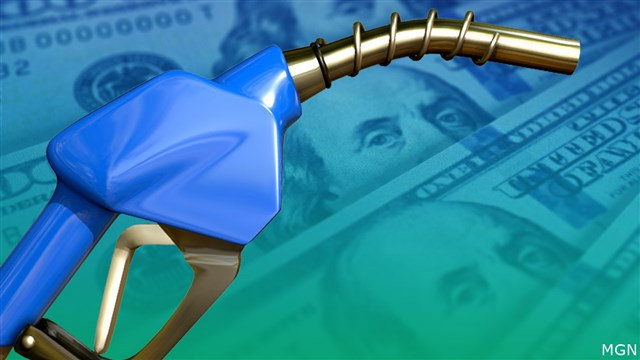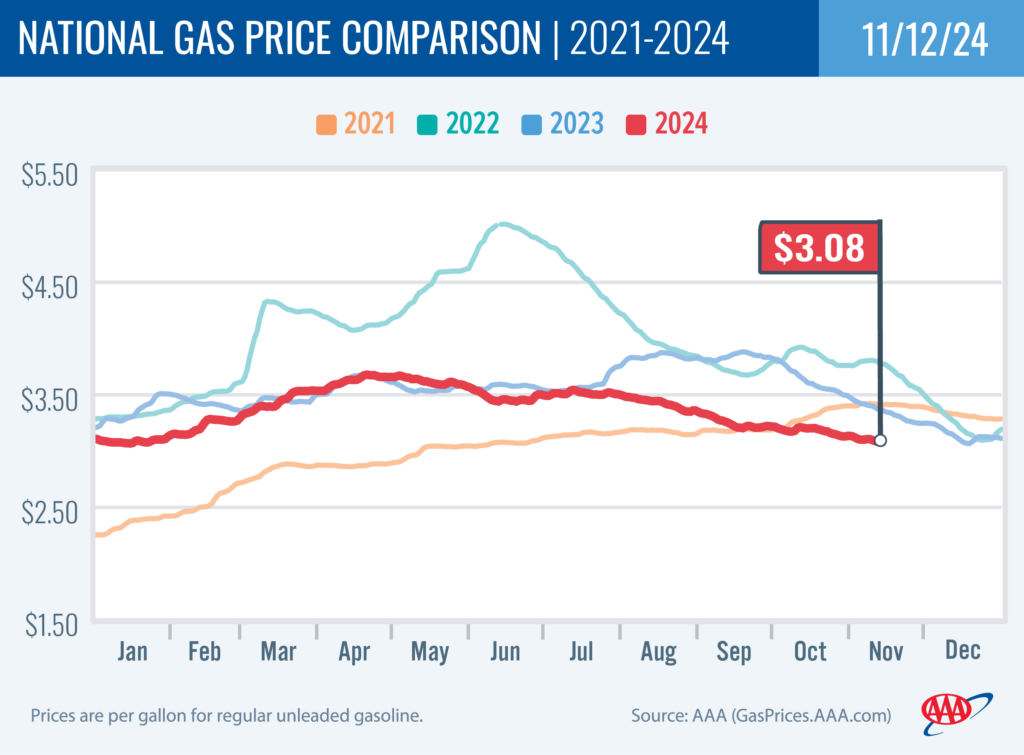Oregon’s gas prices still falling, AAA says – and in Bend, the new Costco’s gas pumps are factor in state’s lowest price

BEND, Ore. (KTVZ) – Low crude oil prices and the tepid demand for gas that we normally see this time of year continue to put downward pressure on pump prices, AAA Oregon/Idaho reports - but in Bend, the recent arrival of a new, larger Bend Costco and its gas pumps also are playing a role.
In fact, the latest report shows Bend drivers paying the lowest gas price in the state, at about $3.31 a gallon - that's 27 cents a gallon lower than the statewide average and 43 cents cheaper than Portland (though still 24 cents a gallon above the national average gas price).
Here's the rest of AAA's weekly Oregon gas price report. Kelsey McGee is speaking with AAA's Marie Dodds and a cross-country motorist for a report coming up on NewsChannel 21 at Five:
The national and Oregon averages for regular gas are both very close to their year-to-date lows and are expected to fall below the 2024 low prices in the coming days. For the week, the national average for regular slips two cents to $3.08 a gallon. The Oregon average loses three cents to $3.59 a gallon.

“The Oregon and national averages for regular gas are almost down to the lowest prices we’ve seen so far in 2024. Both averages are expected to fall to new year-to-date lows in the coming days,” says Marie Dodds, public affairs director for AAA Oregon/Idaho.
The Oregon average began 2024 at $3.79 a gallon compared to $3.59 today. Its lowest price so far this year is $3.58 on February 14 and the highest is nearly $4.51 on May 1. The national average started the year at $3.11 and is at $3.08 today. Its lowest price so far this year is just under $3.07 on January 15 and the highest is just under $3.68 on April 19.
The Oregon average is at its lowest price since February of this year while the national average is at its lowest price since January. This week, only one Oregon county still has an average above $4 a gallon: Wallowa ($4.12), same as a week ago.
Gas prices typically drop in the fall, due to the switch from summer-blend to winter-blend fuel, which costs less to produce. The switch starts in September. Many areas, including Oregon, can sell winter-blend fuel starting September 15. However, Northern and Southern California require summer-blend fuel through October 31.
Meanwhile, crude oil production in the U.S. remains at a record high. The U.S. Energy Information Administration (EIA) reports that crude production in this country is holding steady at 13.5 million barrels per day for the week ending Nov.1. This is the fourth consecutive week that U.S. output has been at this level The previous record was 13.4 million barrels per day first reached in August. The U.S. has been the top producer of crude oil in the world since 2018 and has been increasing its oil production since about 2009.
The U.S. price of crude oil (West Texas Intermediate) has been between about $67 and $74 per barrel since mid-October. Prices fell late last week and at the start of this week as OPEC+ cut its forecast for global oil demand growth in 2024 and due to worry over soft economic growth in China.
Crude prices are impacted by economic news as well as geopolitical events around the world including the unrest in the Middle East and the war between Russia and Ukraine. In addition, production cuts by OPEC+ have tightened global crude oil supplies, which will continue to impact prices. Hurricane season can also impact crude oil prices, if a major storm impacts infrastructure in the Gulf of Mexico. Hurricane season runs from June 1 to November 30.
The price of crude oil reached the year-to-date high of nearly $87 per barrel on April 5. Major drivers of elevated crude prices have been the unrest in the Middle East, the decision by OPEC+ to keep oil production cuts in place, and Ukrainian attacks on Russian refineries. Russia is a top global oil producer, behind the U.S. and Saudi Arabia, and the refinery attacks have reduced output. Crude prices have been volatile after the attack on Israel by Hamas in October 2023. While Israel and the Palestinian territory are not oil producers, concerns remain that the conflict could spread in the Middle East, which could potentially impact crude production in other oil-producing nations in the region.
Crude oil is trading around $68 today compared to $72 a week ago and $78 a year ago. In 2023, West Texas Intermediate ranged between $63 and $95 per barrel. Crude reached recent highs of $123.70 on March 8, 2022, shortly after the Russian invasion of Ukraine, and $122.11 per barrel on June 8, 2022. The all-time high for WTI crude oil is $147.27 in July 2008.
Crude oil is the main ingredient in gasoline and diesel, so pump prices are impacted by crude prices on the global markets. On average, about 53% of what we pay for in a gallon of gasoline is for the price of crude oil, 11% is refining, 20% distribution and marketing, and 16% are taxes, according to the U.S. Energy Information Administration.
Demand for gasoline in the U.S. slid from 9.16 million b/d to 8.82 million b/d for the week ending November 1, according to the U.S. Energy Information Administration (EIA). This compares to 9.49 million b/d a year ago. Meanwhile, total domestic gasoline stocks rose from 210.9 million barrels to 211.3, while gasoline production increased slightly last week, averaging 9.7 million barrels daily.
As noted above, crude oil production in the U.S. holds steady at 13.5 million barrels per day, according to the EIA. This surpasses the previous record high of 13.4 million barrels per day last reached earlier this month and in August of this year. The U.S. produces more crude oil than any other country, according to the EIA.
Pump prices should continue to decline, if crude oil prices remain relatively low. Other drivers of lower pump prices are the usual seasonal factors of tepid gasoline demand and cheaper winter-blend fuel.
Quick stats
Oregon is one of 41 states and the District of Columbia where prices are lower now than a week ago. Ohio (-14 cents) has the largest week-over-week drop in the nation. New Mexico (+3 cents) has the biggest week-over-week increase.
Hawaii ($4.59) has the most expensive gas in the nation for the second week in a row. California ($4.51) is second and Washington ($4.01) is third. These are the three states with averages at or above $4 a gallon, same as a week ago. This week 20 states and the District of Columbia have averages in the $3-range. There are 27 states with an average in the $2 range this week.
The cheapest gas in the nation is in Oklahoma ($2.59) and Texas ($2.65). No state has had an average below $2 a gallon since January 7, 2021, when Mississippi and Texas were below that threshold. At the time, the COVID-19 pandemic drove significant declines in crude oil and gasoline demand in the U.S. and around the world.
The difference between the most expensive and least expensive states is $2.00 this week, compared to $1.94 a week ago.
Oregon is one of 49 states and the District of Columbia with lower prices now than a month ago. The national average is 13 cents less and the Oregon average is nine cents less than a month ago. Ohio (-34 cents) has the largest month-over-month drop in the nation. Georgia (+21 cents) is the only state with a month-over-month increase.
Oregon is one of 49 states and the District of Columbia with lower prices now than a year ago. The national average is 29 cents less and the Oregon average is 63 cents less than a year ago. This is the largest year-over-year drop in the nation.
West Coast
The West Coast region continues to have the most expensive pump prices in the nation with six of the seven states in the top 10. It’s typical for the West Coast to have six or seven states in the top 10 as this region tends to consistently have fairly tight supplies, consuming about as much gasoline as is produced. In addition, this region is located relatively far from parts of the country where oil drilling, production and refining occurs, so transportation costs are higher. And environmental programs in this region add to the cost of production, storage and distribution.
| Rank | Region | Price on 11/12/2024 |
| 1 | Hawaii | $4.59 |
| 2 | California | $4.51 |
| 3 | Washington | $4.01 |
| 4 | Nevada | $3.78 |
| 5 | Oregon | $3.59 |
| 6 | Alaska | $3.55 |
| 7 | Pennsylvania | $3.28 |
| 8 | District of Columbia | $3.25 |
| 9 | Illinois | $3.21 |
| 10 | Idaho | $3.21 |
As mentioned above, Hawaii has the most expensive gas in the country for the second week in a row. California, Washington, Nevada, Oregon, and Alaska round out the top six. Arizona ($3.20) is 12th. Oregon is fifth for the 13th week in a row.
Five of the seven states in the West Coast region are seeing small declines in gas prices on the week: Alaska (-4 cents), California (-3 cents), Oregon (-3 cents), Arizona (-2 cents), and Washington (-2 cents). Hawaii (+1 cent) and Nevada (+1 cent) have small week-over-week increases.
The refinery utilization rate on the West Coast rose from 86.4% to 87.5% for the week ending November 1. This rate has ranged between about 75% to 97% in the last year. The latest national refinery utilization rate increased from 89.1% to 90.5%. The refinery utilization rate measures how much crude oil refineries are processing as a percentage of their maximum capacity. A low or declining rate can put upward pressure on pump prices, while a high or rising rate can put downward pressure on pump prices.
According to EIA’s latest weekly report, total gas stocks in the region decreased from 26.06 million bbl. to 25.80 million bbl.
An increase in the refinery utilization rate and/or a high rate can put downward pressure on pump prices, and a decrease in gasoline stocks can put upward pressure on pump prices.
Oil market dynamics
Crude oil prices declined Friday and Monday as the markets digested the latest demand forecast from OPEC+ where the cartel lowered its projection for next year. Markets are also concerned about slow economic growth in China, which imports more oil than any other country in the world. Meanwhile, the EIA reports that U.S. crude oil inventories increased by 2.1 million barrels from the previous week. At 427.7 million barrels, U.S. crude oil inventories are about 5% below the five-year average for this time of year.
At the close of Friday’s formal trading session, WTI fell $1.98 to settle at $70.38. At the close of Monday’s formal trading session, WTI lost $2.34 to settle at $68.04. Today crude is trading around $68 compared to $72 a week ago. Crude prices are about $10 less than a year ago.
Drivers can find current gas prices along their route with the free AAA Mobile app for iPhone, iPad and Android. The app can also be used to map a route, find discounts, book a hotel and access AAA roadside assistance. Learn more at AAA.com/mobile.

Diesel
For the week, the national average ticks down one cent to $3.55 a gallon. The record high is $5.816 set on June 19, 2022. The Oregon average slips half a cent to $3.89. The record high is $6.47 set on July 3, 2022. A year ago the national average for diesel was $4.36 and the Oregon average was $4.79.
Find current fuel prices at GasPrices.AAA.com.




